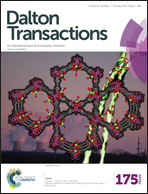Exploring the acid-catalyzed substitution mechanism of [Fe4S4Cl4]2−†
Abstract
Kinetic studies on the acid-catalyzed substitution reactions of the teminal chloro-ligands in [Fe4S4Cl4]2− by PhS− in the presence of the acids NHR3+ (R = Me, Prn or Bun) are reported. Although these acids have very similar pKas (17.6–18.4) the reactions show a variety of different kinetics, some of which are inconsistent with a mechanism involving simple protonation of the cluster followed by substitution of a terminal ligand. The observed behaviour is more consistent with the recently proposed mechanism in which Fe–(μ3-SH) bond elongation/cleavage occurs upon protonation of a μ3-S, and suggests that both the acidity and bulk of the acid is important in the protonation step. Other studies have determined the activation parameters (ΔH‡ and ΔS‡) for both the protonation and substitution steps of the acid-catalyzed substitution reactions of [Fe4S4X4]2− (X = Cl or SEt). A significantly negative ΔS‡ is observed for the substitution steps of both clusters indicating associative pathways. This is inconsistent with earlier interpretation of the kinetics of these reactions (based exclusively on the dependence of the rate on the concentration of nucleophile) and indicates that there is no dissociative substitution mechanism and the pathway associated with a zero order dependence on the concentration of PhS− involves associative substitution with the solvent (MeCN) being the nucleophile.
![Graphical abstract: Exploring the acid-catalyzed substitution mechanism of [Fe4S4Cl4]2−](/en/Image/Get?imageInfo.ImageType=GA&imageInfo.ImageIdentifier.ManuscriptID=C5DT04008F&imageInfo.ImageIdentifier.Year=2016)

 Please wait while we load your content...
Please wait while we load your content...